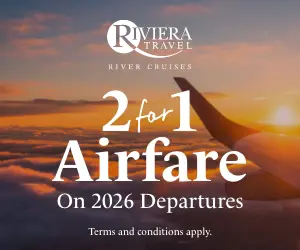FITs: A Booming Market and an Opportunity for Agents
by Ana Figueroa |
This is the first of two interviews with Avanti Destination’s Harry Daalgard on FITs
Fully independent travel. Foreign independent tour. Whichever definition you ascribe to the acronym FIT, one thing is certain.
FITs are an increasingly popular form of travel as more clients forego off-the-shelf packaged tours in favor of bespoke itineraries.
Selling FITs is an opportunity for travel agents to showcase their expertise—and prove their value to clients, according to Harry Dalgaard, founder and president of Avanti Destinations. The company specializes in independent travel to Europe and Central and South America.
Travel Market Report spoke with Dalgaard about trends in FIT and FIT travel to Europe.
Many tour operators tell us that FIT business is booming. Do you agree?
Dalgaard: I’ve been in the market for 34 years. The growth we’ve seen in our area of specialization is extraordinary. At Avanti, our business to Europe has more than doubled in the last four years.
At the moment there’s a perception that you’re getting a lot of bang for the buck there. We’re seeing the lowest exchange rates in many years. Many people are jumping at the opportunity to go there because the Euro may not stay that low for long.
Other than a weak Euro at the moment, what trends do you think are driving the growth of FITs?
Dalgaard: I think the market is maturing and expanding. There’s been a tremendous amount of growth from the Midwest. Traditionally, that’s been more of an escorted or group market.
But now the folks who’ve already experienced group travel want to go back. This time, they want to sample those destinations on their own.
How do the demographics break down for FITs as opposed to packaged tours?
Dalgaard: Since we’re a straight B2B, we don’t typically have a lot of client data. But we do have age statistics. They tell us that half of our clientele is under 50.
We’re also seeing a growing acceptance of travel professionals by millennials. They’re like boomers in that they like their independence. They also like to use agents. They’re web savvy and they don’t mind research.
But when it’s more than simply a three-night stay in Cancun, they want an advocate on their side. Agents are advocates. They can reach millennials with authentic, unique itineraries.
What’s the strongest argument for FIT travel as opposed to a packaged tour?
Dalgaard: Customized travel is a lot more personal. And it’s so rewarding to have encounters that aren’t pre-planned. Sometimes the greatest experiences happen that way.
We also encourage people to get off the beaten path. In Europe, we want to give them the flexibility to explore beyond the major capital cities. We make it possible for them to go to small villages in Germany, attend a wine fest or experience a traditional festival in Spain.
For example, there’s the Las Fallas Festival in Valencia each March where you’ll see bonfires on every corner. It’s really special if you come across something like that. It’s not mass tourism or grandstands. But it’s definitely authentic.
What are the biggest advantages for travel agents in booking FITs?
Daalgard: There’s value in showing your expertise to the client. You’re providing them with a customized vacation. Agents also earn a good commission on lots of things that clients can pre-book.
There are so many things such as day sightseeing tours that concierge ends up booking. In Paris, for example, you know they’re going to take a day tour to Versailles, to the Normandy beaches, to the Loire chateaux. Why not get your commission on those things?
What other destinations in Europe are doing well for FIT business?
Dalgaard: Portugal and Andalusia, Spain are very strong for us. Iceland is probably the highest growth product in terms of percentage. The stopover opportunities with Icelandair make it very attractive.
It’s also seen as an adventure destination and it’s very appealing to millennials. You have a lot of people going up to see the Aurora Borealis, or to dive under frozen lakes.
Other tour operators tell us that the growing river cruise market is helping their business. Do you agree?
Dalgaard: Definitely. We’re seeing a tremendous benefit. These aren’t mass market cruises. The ships carry 150 passengers.
Most of them are interested in being away for about 10 to 14 days. The average cruise is one week. So the passengers are looking for some time to add on to the front or the back.
We’re seeing people get off in Passau, make their way to Prague or Vienna and fly out from there. It’s not just central Europe; people are looking for stays in places like Bordeaux and Lyon. For agents, it’s a great opportunity to sell some additional pre- or post-cruise stays to their river cruise clients.
What about ocean cruises?
Dalgaard: They’re also bringing in extra FIT business. Baltic Sea cruises are leading to tremendous growth in Copenhagen and Stockholm, two big ports. Both are lovely cities, and the chance to plan some extra time there is something agents should jump at.
Norway is going crazy with the whole “Frozen” phenomenon. It’s hard to imagine that a cartoon aimed at kids is generating interest, but it is. Everyone wants to go there. It’s lovely, you can’t blame them.
Next time: The FIT market in Latin and South America
























